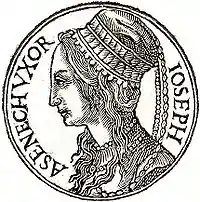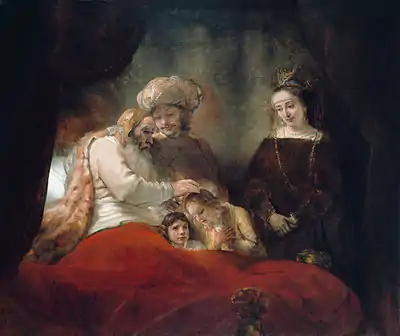Asenath
Asenath (/ˈæsɪnæθ/, Hebrew: אָסְנַת, Modern: ʾAsənat, Tiberian: ʾĀsenaṯ) is a minor figure in the Book of Genesis. Asenath was a high-born, aristocratic Egyptian woman.[1] She was the wife of Joseph and the mother of his sons, Manasseh and Ephraim. There are two Rabbinic approaches to Asenath. One view is that she is an ethnic Egyptian woman that converted to marry Joseph. This view has her accepting the Lord before marriage and then raises her two sons in the tenets of Judaism. This tradition presents her as a positive example of conversion, and places her among the devout women converts.The other approach argues she is not Egyptian by descent, but was from the family of Jacob. The traditions that trace her to the family of Jacob relate that she was born the daughter of Dinah after being raped by Shechem. Dinah left her on the wall of Egypt where she was later found by Potiphera.[2] She was raised by Potiphera and his wife, who was barren, as their own child. Her importance is related to the birth of her two sons, who later become forefathers of two of the twelve tribes of Israel.[1]


)-Bode_museum-_Berlin.jpg.webp)
Name
Her name is believed to derive from the Ancient Egyptian js.w-(n)-n(j)t, meaning "belonging/she belongs to Neith". Neith (ענת ʿnt) Neith was an Egyptian goddess.[3][2]
"Asenath" or "Osnat" (Hebrew: אָסְנַת, Modern: Osnát, Tiberian: ʾåsənaṯ) is a commonly used female first name in present-day Israel.
Portrayal
First mentioned in Genesis 41:45, Asenath is said to be the wife of Joseph and the mother of his sons, Manasseh and Ephraim. In the Book of Genesis, she is referred to as the daughter of Potipherah priest of On (Gk. Heliopolis). In the Book of Jubilees, she is said to be given to Joseph to marry by Pharaoh, a daughter of Potiphar, a high priest of Heliopolis, with no clarification as to whether or not this Potiphar is the same Potiphar whose wife falsely accused Joseph of attempting to rape her. While in the Midrash and Targum Pseudo-Jonathan, she is said to be the daughter of Dinah, Joseph's sister, and Shechem, born of an illicit union, described as either premarital sex or rape, depending on the narrative.[4][5][6] A later-date apocryphal publication, written in Greek, believed to be a Christian document, called Joseph and Aseneth, supposedly details their relationship and their 48-year long reign over Egypt; in it, Asenath weds Joseph, whose brothers Dan and Gad plot to kill him for the sake of Pharaoh's son, who wants Asenath to be his wife, only for their efforts to be thwarted by Joseph's younger brother Benjamin.
Depictions

 This painted image, which is part of a 1475 Flemish manuscript, shows Aseneth offering honey, wine, and bread to an angel.[9] This image was likely inspired by an apocryphal text that describes Aseneth being visited by an angel after she rejects paganism and offering the angel bread and wine. In turn, the angel gives Aseneth a honeycomb.[10]
This painted image, which is part of a 1475 Flemish manuscript, shows Aseneth offering honey, wine, and bread to an angel.[9] This image was likely inspired by an apocryphal text that describes Aseneth being visited by an angel after she rejects paganism and offering the angel bread and wine. In turn, the angel gives Aseneth a honeycomb.[10]
 This Rembrandt work shows Aseneth standing with her husband, Joseph, and her sons, Manasseh and Ephraim, as her father-in-law, Jacob, blesses her sons.[13]
This Rembrandt work shows Aseneth standing with her husband, Joseph, and her sons, Manasseh and Ephraim, as her father-in-law, Jacob, blesses her sons.[13] This image from an illuminated manuscript dating back to the 6th century shows Jacob blessing Joseph and Aseneth's sons, Ephraim and Manasseh, while Joseph and Aseneth look on.[14]
This image from an illuminated manuscript dating back to the 6th century shows Jacob blessing Joseph and Aseneth's sons, Ephraim and Manasseh, while Joseph and Aseneth look on.[14] This mosaic in the Venetian Basilica di San Marco shows a midwife presenting the newborn Ephraim to Joseph. Aseneth and Manasseh are also present.[15]
This mosaic in the Venetian Basilica di San Marco shows a midwife presenting the newborn Ephraim to Joseph. Aseneth and Manasseh are also present.[15]
Joseph and Asenath
Joseph and Asenath’s relationship is mentioned in three verses in the bible. Their relationship is first mentioned in Genesis 41:45. The Pharaoh is said to have gave Joseph, Asenath daughter of Potiphera, priest of On, as his wife. It is later mentioned in Genesis 41:50 that before the years of famine, Joseph had two sons with Asenath. Those two sons were named Manasseh, who was the first born and the other son was named Ephraim, who was the second born. Later in Genesis 46:20 Joseph and Asenath are mentioned in the family of Jacob which mentions that in Egypt, Joseph had two sons named Manasseh and Ephraim, whom Asenath, daughter of Potiphera, the priest of On, bore to Joseph.
References
| Wikimedia Commons has media related to Joseph and Asenath. |
- "The Egyptian woman Asenath in the Bible". Retrieved 18 November 2020.
- "Asenath: Midrash and Aggadah | Jewish Women's Archive". jwa.org.
- "Asenath - Name's Meaning of Asenath". Name-Doctor.com.
- "Asenath: Bible | Jewish Women's Archive". jwa.org. Retrieved 2019-09-05.
- "Jubilees 40". www.pseudepigrapha.com. Retrieved 2019-09-05.
- Pirke De-Rabbi Eliezer, chapter 38.
- "The Repentance of Aseneth (Getty Museum)". The J. Paul Getty in Los Angeles. Retrieved 2020-11-05.
- "ASENATH - JewishEncyclopedia.com". www.jewishencyclopedia.com. Retrieved 2020-11-05.
- "Aseneth Offering Bread, Wine, and Honey to an Angel (Getty Museum)". The J. Paul Getty in Los Angeles. Retrieved 2020-11-04.
- "ASENATH - JewishEncyclopedia.com". www.jewishencyclopedia.com. Retrieved 2020-11-05.
- "Aseneth Requesting the Angel's Blessing of Seven Young Women (Getty Museum)". The J. Paul Getty in Los Angeles. Retrieved 2020-11-05.
- "ASENATH - JewishEncyclopedia.com". www.jewishencyclopedia.com. Retrieved 2020-11-05.
- "Web Gallery of Art, searchable fine arts image database". www.wga.hu. Retrieved 2020-11-05.
- Zdansky, Hannah (February 28, 2018). ""Of hiest God, Asneth, blessed thu be": Female Readers and The Storie of Asneth". Medieval Studies Research Blog. Retrieved November 10, 2020.
- Zdansky, Hannah (February 28, 2018). ""Of hiest God, Asneth, blessed thu be": Female Readers and The Storie of Asneth". Medieval Studies Research Blog. Retrieved November 10, 2020.
